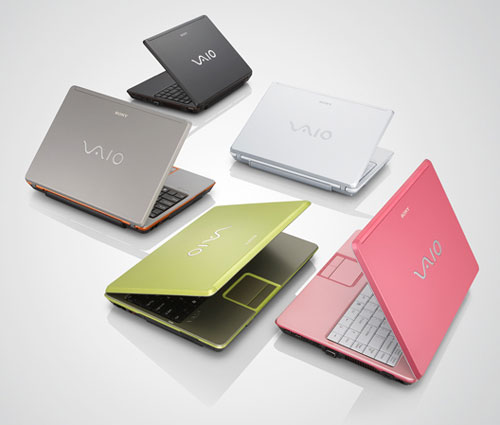Hosted by site sponsor WebMate.
White & Black MacBook Q&A - Revised June 1, 2007
To be notified of new Q&As, sign up for EveryMac.com's bimonthly email list.
How does the "Late 2006" MacBook Core 2 Duo compare to a similar Core 2 Duo Windows notebook?
Please note that all systems mentioned in this Q&A have been discontinued. The "Late 2006" MacBook Core 2 Duo series was replaced by the "Mid-2007" MacBook Core 2 Duo series.
For the original MacBook, EveryMac.com compared the Apple notebook to the Sony VAIO VGN-SZ240.
At the time the "Late 2006" MacBook was released, Sony offered a Core 2 Duo powered notebook from the SZ series, the Sony VAIO VGN-SZ390. However, as mentioned in the original comparison, the VAIO SZ models have a hybrid graphics system that is substantially more powerful than the integrated graphics provided by the MacBook and use carbon fiber cases that are nearly a pound lighter than the MacBook housing.
The Sony VAIO VGN-SZ240 was roughly US$451 more than the original entry-level MacBook "Core Duo" 1.83 13-Inch at the time of introduction, and when configured equivalently, the Sony VAIO VGN-SZ390 is approximately US$860 more than the "Late 2006" mid-level MacBook "Core 2 Duo" 2.0 13-Inch (White).
For the "Late 2006" MacBook Core 2 Duo, however, a better comparison likely is between the MacBook "Core 2 Duo" 2.0 13-Inch (Black) and the Sony VAIO VGN-C190P/H. The Sony VAIO C series was introduced on September 27, 2006, more than a month before Apple bumped the MacBook series to use Core 2 Duo processors. Unlike the SZ series, the C series of VAIO notebooks use heavier plastic cases like the MacBook and have integrated graphics instead of a more expensive hybrid graphics system.

Photo Credit: Sony
The Sony VAIO C Series shipped in "seashell white, blush pink, spring green, espresso black and urban gray" compared to white or black for the MacBook. Apart from color options, the systems are similar externally, each has a 13.3" TFT active matrix display with a native resolution of 1280x800 and weighs a bit over five pounds (5.07 pounds for the VAIO and 5.2 pounds for the MacBook). The MacBook boasts a "glossy" display and the VAIO a "anti-reflective coating".
"Off the shelf" both are configured with 2.0 GHz Intel "Core 2 Duo" processors (T7200) -- each with two independent processor "cores" on a single silicon chip on a 667 MHz frontside bus and Intel GMA 950 "integrated graphics" with 64 MB of system memory "borrowed" on the MacBook and 128 MB on the VAIO. The MacBook supports up to 2 GB 667 MHz DDR2 SDRAM (PC2-5300) RAM and the VAIO supports up to 2 GB of older PC2-4200 DDR2 SDRAM. Each was configured by default with a 120 GB Serial ATA 5400 RPM hard drive with anti-shock technology and an optical drive capable of writing to dual-layer DVD. One notable difference is that the VAIO C series does not have an integrated camera, and the MacBook does.
Connectivity is similar as well, but not identical. The MacBook and VAIO both have 802.11a/g (dubbed "AirPort Extreme" for the MacBook, which supports 802.11n as well after a firmware update), a FireWire "400" port (dubbed i.Link on the VAIO), and two USB 2.0 ports. The MacBook also has Gigabit Ethernet, Bluetooth 2.0+EDR, optical digital audio in/out, mini-DVI out, and the "MagSafe" power connector. The VAIO has inferior 10/100Base-T Ethernet, Bluetooth 1.1 (2.0+EDR is not specified, so one can assume that it's the earlier specification), analog mic and sound out jacks, and VGA out. However, the VAIO does have an internal modem and a Memory Stick DUO slot. Neither system supports ExpressCard/34 or PC card expansion options.
In the default configuration, the "Late 2006" MacBook "Core 2 Duo" 2.0 13-Inch (Black) cost US$1499 and the Sony VAIO VGN-C190P/H cost US$1549. Priced US$50 less, the MacBook certainly is competitive, and the MacBook is the only one of the two that Apple supports running MacOS X. The value of the operating system should be acknowledged as well.
Permalink | Report an Error/Typo | Sign Up for Site Update Notices
<< White & Black MacBook Q&A (Main)
Established in 1996, EveryMac.com has been created by experts with decades of experience with Apple hardware. EveryMac.com includes, and always has included, original research incorporating detailed, hands-on inspection of packaging, computers, and devices as well as extensive real-world use. All information is provided in good faith, but no website or person is perfect. Accordingly, EveryMac.com is provided "as is" without warranty of any kind whatsoever. EveryMac.com, and the authors thereof, shall not be held responsible or liable, under any circumstances, for any damages resulting from the use or inability to use the information within. For complete disclaimer and copyright information please read and understand the Terms of Use and the Privacy Policy before using EveryMac.com. Copying, scraping, or use of any content without expressed permission is not allowed, although links to any page are welcomed and appreciated.
